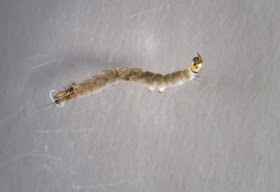Thursday, December 23, 2010
Midges
The midge is one of the most common insects we find in our streams -- and we often find them in large numbers. The largest numbers seem to show up in spring and fall samples, but they are present all year long, and the largest numbers tend to be found in the poorer quality streams. In our worst streams, they can dominate the sample, along with common netspinning caddisflies. They are often very tiny (the photo above was shot through a microscope), so tiny in fact that untrained eyes won't see them at all on a net. They often give their presence away by rapidly wiggling in an "S" shape when they are squirted with water.
But the midge in the photo above -- what most stream monitors mean when they refer to a "midge" -- is only one type of midge that we find in our streams. This is a "non-biting midge," family Chironomidae; many fly fisherman, in fact, refer to them as Chironomids. Most Chironomids are light yellow to clear in color, but we also see red, green, and black Chironomid midges. They are highly tolerant of stream impairment, normally given a value of "6" on a scale of 1 (intolerant) to 10 (very tolerant).
The other midges we find in our streams are 1) "biting midges/no-see-ums" (Ceratopogonidae), 2) Dixid midges (Dixidae), and 3) Net-winged midges (Blephariceridae).
Biting midges (Cerats) are thinner and longer than Chironomids; they also lack prolegs, and the head is long and pointed. They are often "zebra" colored, i.e. segmented in black and white. Although most tolerance scales also put them at "6," I've only seen them, to my surprise, in our very best streams -- i.e. the "reference streams" used by StreamWatch. I'm not sure what to make of this (???).
Dixid midges (family Dixidae) are rarely seen in our streams: I've only seen them in three locations;
1) the StreamWatch reference site for Albemarle County (which will remain unnamed), 2) Whippoorwill branch of the Mechums River, and 3) the small stream that runs through Greene County park. These
are good streams, and Dixid midges are very intolerant of impairment (TV's of 1-3).
These are "Net-winged midges" (Blephariceridae) -- again highly magnified. As with Dixid midges, these are found in very few of our streams, and they too have low tolerance values (in most scales, a value of less than 1). I've found them -- always in the winter, by spring they're pupating -- in the Doyles River, the Lynch River, and Buck Mt. Creek. The photo above shows the dorsal view on the left and the ventral view on the right (head to the bottom in both cases). The little "suckers" on the ventral side of this midge are used to keep it attached to rocks in fast flowing water.




Excellent info of this line "These are "Net-winged midges" (Blephariceridae) -- again highly magnified. As with Dixid midges, these are found in very few of our streams, and they too have low tolerance values (in most scales, a value of less than 1)."
ReplyDeleteShade Netting
Such a amazing article....
ReplyDeletebungee cords